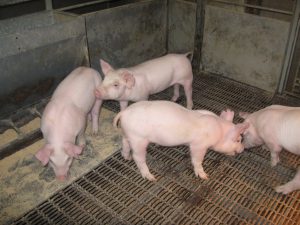Main Content
For this Agent, there are few memories more traumatic than high school math. The variables in the equation, the x-factors, the decimal being in the right location! Years ago as a young student, the math problems would manifest in my imagination as, “if a train leaves Penn Station at 3:00 p.m. going 35 miles per hour for 2 hours, how much snow fell in Amble, Michigan?” To say math was perplexing to me as a youth would be an understatement!
Obviously that is an exaggeration to the extreme, but that is how it felt. Of course, the reality is that math is far from scary. In fact, no matter how silly the previous example is, in the “real world,” such as in 4-H projects, math is very useful! Let us therefore work out a math problem pertaining to 4-H swine projects – specifically, when should 4-H members start to purchase their 4-H swine project?
The factors of our math problem are as follows:
- County fair weigh-in day = August 1st
- Beginning weight of market swine at time of purchase = 50 lbs.
- Ideal average daily gain for market swine projects = 1.5 lbs. per day
- Desired market weight for swine projects = 250 lbs.
Working through this particular math problem, let us think about the end goal for the project – that is, having the swine project “market ready” for the county fair. In our equation, we are assuming the beginning weight of our market swine project to be 50 lbs. A pig should weigh 40-60 lbs. at 8-10 weeks of age. If the animal is less than this, it may not reach market weight in time for fair. Thus, the beginning weight of your animal may be different, but for this exercise we are going to use 50 lbs. as our starting point. With our end goal in mind (for this particular equation, we assume 250 lbs., but generally 240 lbs. – 270 lbs. is considered an ideal market weight range…, but be sure to consult your local fair rules for those specific details), and our fair date provided (again, here we assume an August 1st weigh-in date, but fairs in New Jersey can be as early as late-spring to as late as early-fall), let us plug in the numbers to figure out when to purchase market swine projects.
Written out, our equation will look something like this:
(Desired Weight – Beginning Weight) / Average Daily Gain = Days to Feed Swine Project
When we plug in the numbers, our equation evolves to looks like this:
(250 lbs. – 50 lbs.) / 1.5 lbs. per day = ___ Days to Feed Market Swine Project
Simple math gives us an answer of 133.33. As stated earlier, for our equation, the county weigh-in date is August 1st. When we subtract 133 days from August 1st, we have a date of March 21st (just in time for spring!). That means we will have (roughly) 4.5 months to get our 4-H market swine project from 50 lbs. to 250 lbs. in time for the county fair.
As with any “real world” math problem, there are going to be many other variables in the equation. For example, in our equation we assumed the daily gain to be 1.5 lbs., but many times 4-H market pigs will gain 2+ lbs. per day (there are many reasons for this, including favorable genetics, individualized care, specialized housing environments, etc.). Environmental factors may also skew the math (for example, in the hot summer months, a pig may be less inclined to eat as much as it does on a cool spring day). Even so, working through the math, 4-H youth members can see that math does not have to be scary. In point of fact, having a greater sense of the implications each variable has in the equation, 4-H members can gain a better understanding of how math can help them plan for future success.
Matthew Newman, County 4-H Agent, Rutgers Cooperative Extension